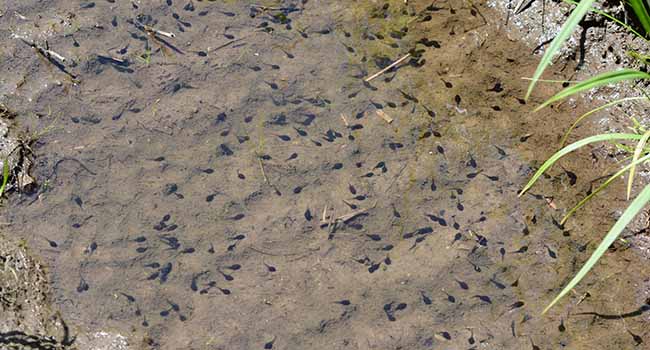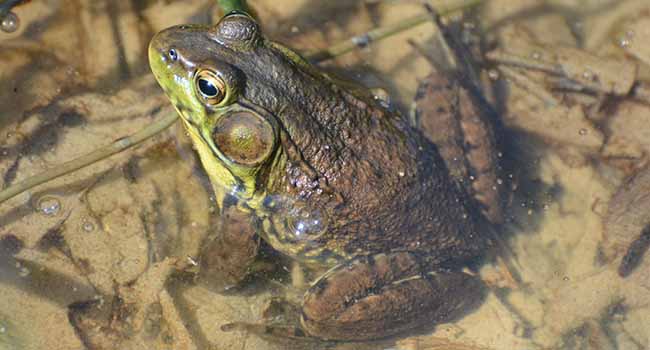
Tadpoles in a vernal pond- photo by Geoff Carpentier
 Have you ever walked in a forest in early spring and seen all the beautiful little ponds that dot the landscape? Have you gone there again in July and wondered where they went?
Have you ever walked in a forest in early spring and seen all the beautiful little ponds that dot the landscape? Have you gone there again in July and wondered where they went?
I can explain what’s happening here and why they’re so critical to many animals.
Vernal pools – also known as ephemeral, autumnal, spring or temporary woodland ponds – typically fill with water in the autumn or winter and remain through the spring and into early summer.
The advantage they have for species that use them is they don’t contain permanent water. That means the insects, amphibians and reptiles that use them for breeding don’t have to face predation from fish species, since fish can’t survive in these non-permanent waters.
Myriad wildlife use this habitat – frogs, toads, salamanders, insects and other invertebrates teem in vernal pools, depending on where you live in the country. Strings of floating amphibian eggs can be seen in its depths. Fairy shrimp and other invertebrates abound. Wood frogs sing out their spring songs, sounding like a flock of ducks from its banks, while grey tree frogs, American toads and green frogs lay eggs and live and feed here.
Right now we can hear the peeping of the spring peeper that breeds in vernal ponds and small lakes and bogs. Juvenile stages of dragonflies, caddisflies, mosquitoes, backswimmers and diving beetles breed in there as well.
These ponds are magnets for many salamanders, such as the spotted salamander and red-spotted newt, that lay their egg masses along small twigs in the water.
Of course all this food attracts predators, so it’s not uncommon to find turtles feasting on the eggs of the various frogs and salamanders. You might also find a green heron, a snake or raccoon coming to dine on the adult frogs and salamanders that might still be nearby.
By late spring or early summer, hundreds of young frogs and salamanders leave the pond and complete their life cycle in the surrounding forests. Meanwhile, the pond dries up slowly until the fall rains come and it slowly recharges, ready for next year.
So how do you know it’s a vernal pond?
You really don’t but wildlife does. It’s a temporary water body that seems to have no beginning or end. It’s not stream-fed, nor does it rely on a lake’s overflow. It’s filled with water from rainfall or spring melt that simply collects in a hollow or depression and slowly evaporates until gone.
Local geology makes it possible for these to persist, since shallow depressions in the landscape are essential so the water has somewhere to collect. In central Canada, we have been heavily glaciated and forested, so we have many of these places where water can pool.
Generally, these ponds are quite small (15 to 20 metres wide and one to 1.5 metres deep). Often the edges are heavily foliated with small shrubs and flowering plants.
Can you still find them into summer?
In a way, but they likely won’t have water in them. Look for compressed black leaf litter, greyish soil, watermarks on surrounding tree trunks and moisture-tolerant vegetation. All these indicators can lead you to these ponds.
So how important are these ponds?
One source indicates that the amphibian species developing in ponds generally amount to more vertebrate biomass than the mass of all the birds and mammals in a forest. Most of our salamanders and many of our frogs can’t survive without them.
As we continue to develop land, they will become increasingly important and, unfortunately, increasingly rare. It may not be long before we simply can’t find salamanders in southern Canada (especially near large built-up areas), nor enjoy the spring frog chorus.
Here’s what you can do if you own land that hosts a pond:
- avoid using chemicals and fertilizers;
- maintain forest canopy;
- don’t add or remove plant debris from the ponds;
- don’t add fish or other animals;
- don’t drain ponds or alter the surrounding watershed.
These may sound like small things but they can have a huge impact.
Right now is an excellent time to go out and check out these ponds because the frogs, toads and salamanders are out there starting their breeding cycle.

Green Frog lounging in a vernal pond- photo by Geoff Carpentier
Geoff Carpentier is a published author, expedition guide and environmental consultant. Visit Geoff online at www.avocetnatureservices.com, on LinkedIn and on Facebook.
The views, opinions and positions expressed by columnists and contributors are the author’s alone. They do not inherently or expressly reflect the views, opinions and/or positions of our publication.

